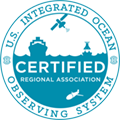Weather & Climate
Climate and weather are two terms used to describe the same atmospheric conditions (temperature, precipitation, etc) on two different time scales: long-term (climate) and short-term (weather). Climate is the long-term weather pattern, typically assessed by a 30 year average of weather. Climate allows us to anticipate general trends for locations throughout the year. For example, two regional climate patterns are:

- Western Washington and Oregon receive more rain in one year than Eastern Washington and Oregon
- The majority of rainfall in western Oregon and Washington will fall during October through March
Weather is what happens on a day to day basis. It cannot be predicted more than a few days to weeks in advance. Weather is much more variable and can have a different pattern than climate. For example, on a given day, the weather in Eastern Washington or Oregon could be wetter than the same day in Western Washington or Oregon.
Areas of Emphasis
Maritime Operations |
Coastal Hazards |
Fisheries & Marine Life |
Marine Ecosystems |
Weather & Climate |
Related Topics
Coastal & Marine Spatial Planning
Related NANOOS Products
NOAA Pacific Marine Environmental Lab (PMEL) Carbon Program
The primary mission is to evaluate the variability in air-sea CO2 fluxes by conducting high resolution time-series measurements of atmospheric boundary layer and surface ocean CO2 partial pressure (pCO2).
Columbia River Climatological Atlas
The Climatological Atlas is a scientific project designed to offer insights into multiple scales of variability of the contemporary Columbia River coastal margin, via statistics of an extensive set of indicators. The focus of the Atlas is on indicators for the estuary and plume, but indicators of external forcing are also included for context.
Puget Sound ORCA
Oceanic Remote Chemical Analyzer (ORCA) measures physical, chemical, and biological water characteristics in Hood Canal.
Cha'ba Buoy
Multi-depth moored buoy deployed off La Push, Washington that collects physical, chemical, and biological water variables.
NANOOS members involved in this effort include:
NOAA Northwest Fisheries Science Center
| National Observing System Partners Alliance for Coastal Technologies (ACT) Southeastern Universities Research Association (SURA) Integrated Ocean Observing System IOOS | |||||||

